VW Passat Tuning
"Putting more pazzaz in your Passat"
The Passat was the car of the year many times over and loved by motoring journalists. It went to show that you could have a family-size car which provided a good driving experience. Sharing much of its platform with the A4 the Passat has much to offer and I would argue has more interior space than the A4.
The Passat is not an exciting car, it has been built to offer practicality but each revision has seen improvements to engines and brought better handling characteristics making it a great base for your tuning project.
Please watch our video introduction to VW Tuning.
As far as tuning the Passat goes we would shy away from the modest engine sizes. To get the most from the chassis you need to get an engine with 130bhp or more. Thankfully the turbo diesels fit the bill nicely with some suitable modifications.
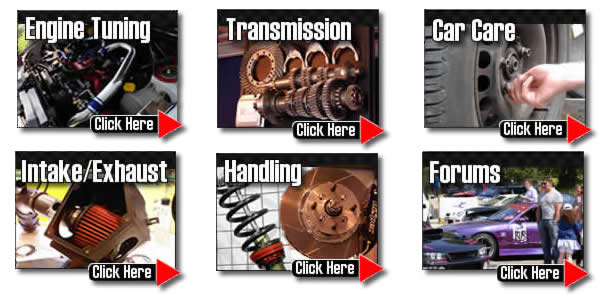
What are the best Passat engines?
We would go for the 1.8T, the 2.0Tfsi the 2.5 and 2.8 V6 engines, and the 1.9 TDi 130 and 2.0 TDi (avoid the 100ps version unless you are desperate for the economy.
Anything less than 130bhp will feel slow with such a large platform, the later TFSi engines are excellent choices and the 170TDi is a real gem when it comes to performance but it can be hard to live with if you only do short journeys.
Let's see what modification options you have in your Passat tuning project.
Handling modifications are usually your first port of call for the Passat. Drop the car optimally somewhere in the region of 35mm and fit stiffer dampers, bigger drops will need other modifications in most instances.
Our aim in Passat engine tuning should be to increase peak power and Torque at the top end from the bottom third of the RPM range, a s pike in power lower than this will add wear to the turbo and cause a lot of wheelspin!
The best power gains come from larger engine sizes. The more you start with the bigger the return on investment so engine swaps are good value mods for small engined cars.
The generations of the Passat
- B1 (Typ 32; 1973)
- B2 (Typ 32B; 1981)
- B3 (Typ 35i; 1988)
- B4 1993 facelift on the B3
- B5 (Typ 3B, 1997) and B5.5 (3BG; 2001)
- B6 (Typ 3C; 2005)
- B7 (2010)
- Passat CC (Coupe version)
- B8 (Typ 3G; 2015)
VW Passat Tuning modifications.
These mods sports parts are usually installed by our members, decide how far you wish to go in your tuning project before you get started.
We have the following detailed engine tuning guides to assist you in deciding which upgrades to do on your Passat. These engines may also make suitable candidates for engine swap projects.
- 1.4 1.5 TFSi tuning
- 1.4 TSi/TFSi/Twincharge tuning
- 1.8T engine Tuning
- 1.8 & 2.0 TFSi (mk1) Tuning
- 1.8 2.0 TFSi (ea888) Tuning
- 2.0 TFSi carbon issue & care guide
- 2.5tfsi tuning
- 3.0 V6 24v TFSI Tuning
- 2.8 V6 30 valve, 24 valve 3.0 V6 30v and 3.2 VR6 Tuning
- 3.6 VR6 Tuning
- 1.6 TDi tuning
- 1.9 TDi tuning
- 2.0 TDI 140-170 tuning
- 2.0 TDI tuning (EA188)
- 2.5 TDI tuning
- 2.7 & 3.0 TDI tuning
- 2.5 Tdi R5
- 3.0 Tdi EA897
Getting the right modified parts for your planned usage of the car is a time and money saver. Stage 3 motorsport parts just don't work well on the road making the car difficult to drive.
Please view our video on VW Passat Mods & Tuning. Subscribe to our new channel and show your support.
Best Engine Mods and tuning upgrades for your Passat
- Clutch upgrades - avoid losing power through a slipping clutch
- Suspension modifications - coilovers and bushing replacement.
- Coilovers, bushing replacement, and attention to the suspension mounts with a strut brace all contribute to the handling improvement of your Passat.
- Lighter flywheel - you'll like the quicker rev speed changes on the majority of models. However, diesel engines should continue to use DMF.
- Upgrade your brakes - Don't only concentrate on speed; you also need to be able to stop it.
- Remapping (particularly on the turbos) engine tuning/remapping is the most cost-effective solution.
- Turbocharger and supercharger upgrades - forced induction is the most effective method of increasing air supply, enabling you to burn more fuel and produce more power. It is one of the most expensive enhancements, but it yields the most benefits.
If we look at Passat mods broken down into the usual Tuning stages we would have...
Typical stage 1 mods often include: Suspension upgrade (drop 21mm - 39 mm.), Panel air filter, Alloy wheels, Sports exhaust, Engine Tunes/Remapping, Lighter flywheel.
Typical stage 2 mods often include: Power/Sport clutch, Ported and polished head, Fast road cam, high flow fuel injector, fuel pump upgrades.
Typical stage 3 mods often include: Sports gearbox, Internal engine upgrades (pistons/head/valves), Adding or upgrading forced induction (turbo/supercharger), Engine balancing, Competition cam.
Peak power is all well and good but for a daily driven car, you need a wide powerband and perhaps extending the rev range.
A good fast road power clutch will help to keep that power going where it should.
Never skimp or expect a standard clutch to cope. Your clutch can lose you loads of power as the power goes up if it starts to break and the standard clutches are only ever good for power gains of up to 45%.
Fit a performance clutch to avoid power loss through the transmission. The best mods in our experience for your Passat are fast road camshaft, remap, induction and exhaust, suspension.
Remaps offer significant power gains on all turbo charged cars. On NA (naturally aspirated) engines the benefits are doubtful, but will help unleash the potential if you have done a lot of mods.
So let's discuss these Passat upgrades and mods in more detail to help your tuning project be the very best it can be.
Passat B5 Suspension Mods.
Fast cornering is important on the track, and suspension plays a role. The track is forgiving, so you can use harsh suspension and lower the car for better aerodynamics and a lower center of gravity.
As the Passat gets older the rubber suspension bushings will degrade, you might hear squeaks, rattles, and bumps and the suspension will not be as tight as it could be.
So your first step in improving the basic setup, and switching to polyurethane bushings is a great idea, but even a fresh set of stock rubber ones will go a long way to making things better.
So, when setting up and picking your daily driver's suspension, what variables and factors must you consider?
Things to consider with suspension upgrades
When designing a car's suspension, engineers must consider speed bumps, uneven surfaces, passenger comfort, and road noise.
Most Passats leaving the factory have soft suspension that doesn't maximize handling or driving pleasure. Track vehicles are set up for driver choice and style, therefore the optimal setting is not just subjective but also depends on the track and road characteristics.
A good suspension system keeps the tires on the road at the ideal angle for maximum contact area. Body roll must be minimized, and the car's center of gravity must be low. For hot hatches with upgraded suspension, Torquecars recommends a 30mm drop.
Common Suspension Mistakes & Urban Myths.
Buying a non-adjustable suspension package that lowers the car 60mm and expecting it to be perfect and provide better handling.
Most kits are highly generic, and suppliers often indicate that they can be used on any or many types of an automobile regardless of chassis design or engine weight!
It's quite false to say that one suspension fits all for all engine, wheel, and Passat weights (the diesel engines are pretty heavy).
An incorrect final drive to wheel hub angle might damage the drive shaft and gearbox.
Changing the ride height also affects how the suspension moves under load, causing tires to rub on the arches and premature tire wear!
It's also a bad idea to buy reduced springs and use regular dampers, or upgrade dampers and use standard springs. The suspension system should be evaluated and upgraded as a whole.
Problems Affecting Ride Height From Low Suspension
Cars look good slammed low. But you lose ground clearance, tires rub in wheel arches, and speed bumps become insurmountable hazards.
Remember that speed bumps will strike the sump and take off the bottom of the engine and most of the front bumpers/fenders of a lowered car. Lower does not always mean better!
TorqueCars recommends a 35mm drop for most road cars, and a 30mm drop for Passats with upgraded suspension (sporty versions which already have lower suspension).
The goal should always be to improve handling, and lowering the automobile reduces airflow under the car, which helps stability.
Remember to use matched lower springs and shocks. The concept of cutting the springs is a terrible one since you are asking a piece of metal engineered to work with a certain strength and flex to perform the same task with substantially less flex and progressive control.
Cut springs will shatter or break without warning - NEVER CUT YOUR SPRINGS!
Ideally, you should acquire a suspension package that allows at least the ride height and preferable the spring and damping rates to be quickly modified on the automobile to fit your driving style.
A good set of coil overs will help allow you to adjust them to suit your driving style. Koni, Bilstein Eibach, and KW are good brands I have used on my project car.
Passat Brake upgrade mods
Bigger brake disks come to mind, but don't forget the pads - these are probably more important than the disks, and indeed bad pads can ruin your Passat's handling.
How do brakes work?
Brakes are vital — moving fast means being able to stop quickly! A brake works by pressing a friction pad against the disc, converting kinetic energy into heat.
This head dissipates, slowing the car's forward motion. Extensive braking causes brake heat buildup, as seen in nighttime motorsports where the brakes glow with heat after heavy use.
To offer you a nice progressive sensation, when you press the brake pedal, the force is transferred to a magic box called a servo, which uses engine power to magnify your foot pressure.
The extra pressure is supplied to the friction pads via a tube filled with braking fluid (liquids do not compress like air).
The braking fluid itself can become quite hot towards the hot brake pad end, putting additional demands on the brake fluid so spec a decent brake fluid with glycol based dot 5.1 fitting the bill nicely.
Performance brake discs
The pad dissipates braking heat over the discs, therefore the cooler the disc stays, the better. A car's stopping power can be improved by fitting larger discs but this will require new calipers and pads to suit the larger disc.
Normally you'd upgrade the discs and pads. A larger disc will have more friction and disperse more heat, so you will instantly benefit.
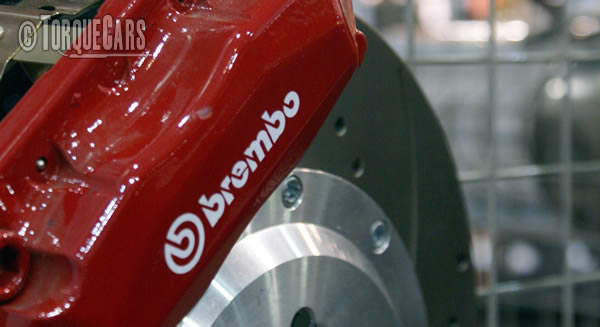
The vented disc, with its central channel, boosts the disc's surface to air ratio, resulting in better and faster cooling.
Drilled discs assist maintain the pads ‘clean and sharp' by increasing the air ratio and preventing gas vapor build up between the pad and the disc. Bigger discs = better cooling, although they may necessitate a different alloy wheel.
Performance brake pads for the Passat
Pad materials. However, high friction brake pads are needed, even if they produce noise and dust.
Racing pads are made with a high friction compound that works best at higher temperatures they also get quite noisy when operating at colder temperatures typical of road use.
Because race grade brake pads only work when very hot, they are unsuitable for road use where braking is done on cold pads or in short bursts.
TorqueCars has determined so far that fast road pads from Pagid, Green Stuff, and Black Diamond are a good compromise between braking and wear.
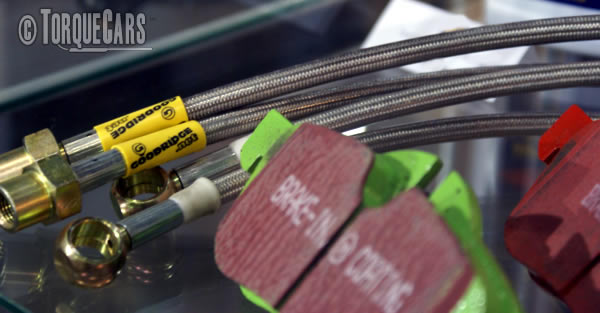
Some performance brake pads produce almost no brake dust and last longer than the normal pads I was using — albeit driving style will affect pad and disc wear.
Easy Passat Brake upgrades on a budget
If you have a basic family car with small discs, you may easily and cheaply purchase brake disks and servos from a performance model in the same family.
The performance brakes (if they fit into the alloy wheels or you need to acquire wider rims) are normally standard on a small family car.
Small cars often share parts with larger executive cars, so a little study and discussion with our forum members can help. Brakes from VW, Audi, Porsche, Skoda, and Seat are interchangeable because most hubs are interchangeable.
Passat Brake Calipers
Next up are calipers (which apply the clamping force) and pistons (which push the calipers).
The more pistons you have, the more clamping force you have, allowing you to employ larger pads.
It's not as simple as creating a dog bone adaptor to put them onto the factory (or larger discs) to replace the factory single or double piston calipers!
The overall volume of brake fluid utilized must match the amount used in the donor master cylinder. The pedal stroke and braking sensation will be altered otherwise, and the pedal will likely move closer to the floor before the brakes operate.
To match the donor vehicle's master cylinder volume, the factory master cylinder may need to be overbored or replaced with a larger unit.
To maximize the effect of upgrading the discs, increase the pad, caliper, and piston count.
Remapping the Passat B5.
What makes OEM maps so bad? A single configuration for everyone generally requires some fiddling with local fuel emission standards and temperatures.
Temperature changes, small flaws, and adverse weather are all factored into timing maps. It's not uncommon for each region's CO2, HC, and NOx emission goals to vary.
Manufacturers do not want consumers to be inconvenienced by mechanical or fuel efficiency issues and because different countries use different fuel grades and have differing degrees of unfavorable weather, a fudged setup of the ECU is required to keep everything working properly.
Each Passat's output can vary by upto 20bhp depending on component quality and assembly. Instead of customizing timing maps for each car, they utilize a one-size-fits-all strategy.
In order to reduce insurance costs and improve fuel efficiency, manufacturers use tunes or remaps to increase engine power and meet the standards they require. This includes requiring a setup that can cope with late or missed regular servicing, dirty plugs and leads, clogged air filters and partly blocked injectors.
We see a 2.0TDi engine coming in power levels from 109hp, 140hp to 170hp and essentially most of the difference is the mapping, and perhaps a different turbocharger.
So when you consider the typical TorqueCars reader will be upgrading components, a tune/remap makes sense.
All current turbocharged Passat engines benefit from remaps, which give 20-30% more power. TorqueCars highly suggests engine tuning/remapping turbocharged automobiles using a rolling road Dyno to fully extract the power from your mods.
Remapping Issues and Drawbacks What are the hidden costs?
- Prepare to service your car more frequently, sometimes halving the service interval to be safe.
- If the map was tuned for high octane fuel, you must be prepared to replace components that break due to the extra work they are doing.
- When an engine is tuned for more power, it puts more strain on components, such as airflow sensors.
- Weak points in an engine frequently show up months after a remap. See our tune/remap troubleshooting guide.
Generally, turbocharger and clutch deficiencies will show up following a remap.
Also, turbos can wear out, essential components like pistons and bearings in the engine require care, and the clutch is less likely to cope with a tune/remap if it is worn or has had a hard life.
What about NASP remaps?
A tune/remap alone will only gain a few BHP if you don't have a turbo (10 percent is typical) bur you might see more or less depending on the other mods you've done.
TorqueCars advises non-turbo automobiles to modify everything else first (cams, pistons, increase compression, engine balance, air intake, exhaust, head work, bigger valves etc...)
After this, you can consider a tune/remap to assist you to get the most out of them.
Turbocharged engine care
Also, a tune/remap often introduces boost from lower down the rpm range, causing the turbo to run faster and hotter, it can also cause a lot of wheelspin so bear this in mind when driving a mapped Passat.
In this case, you must let the turbo cool before turning off the motor, or the oil may degrade, requiring an expensive turbo repair. Installing a turbo timer will also assist keep the engine running until it cools.
Be very skeptical of peak Power Claims Please ignore peak power when comparing maps since some tuners are known to manufacture a power blip or spike to attract attention and grab those headline power figures.
See the graph below which illustrates what we mean.
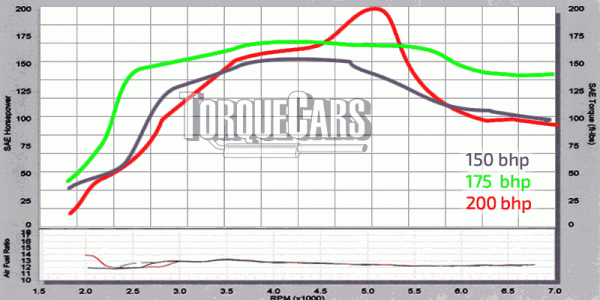
The red plot above shows an increase in power, but power is down everywhere else, whereas the green trace shows a constant gain in power throughout the RPM range.
It also shows peak power at 4000rpm, which is fantastic for an engine that redlines at 7000rpm, providing you a fair spread of extra power where you need it most.
On a map, we want to see a beautiful smooth torque rise throughout the rpm range, with no dips or troughs.
Instead, focus on the total torque curve. More power at the bottom end puts a lot more wear on the turbo as it doesn't get to "cool down" and typically causes traction issues, whereas more power at the top stresses the turbo bearings and internal engine components as they are working much harder.
To find out if the map has ever been tested or studied, you have to go to the company's office. Here you will often find someone with a laptop and they will mess with the fuel and spark advance tables hoping for the best and never actually see the cars they are tuning. Worse still they may even send the map remotely for adjustment and not even have the skills themselves to optimize your car.
Turbo modifications and upgrades for your Passat
The extra power comes with a hidden cost from more engine damage and heat. Remapped petrol engine turbochargers can reach 1100°C and spin at 100,000-150,000rpm.
Recent models with turbos can exceed those speeds and temperatures. It demands lubrication, cooling, and balancing.
We'll show you how to do upgrades on your turbo engine via a turbo-hybrid (based on your OEM casing but with internals from another turbo or with a different design)
Installation of bigger turbo takes additional pipes and labor. As an alternative, most hybrid turbos will work perfectly on standard maps with lower boost levels if the original is simply replaced.
There's a look at the air intake aperture on the turbo where you'll see the compressor wheel, and these may boost at high or low RPMs, depending on your demands and their design.
- A smaller turbo gives a flatter torque curve with reduced lag for road automobiles.
- A hybrid turbo has better bearings, balance, and seals. Reduction of RPM improves boost.
A Guide to Volkswagen and Audi Group Turbochargers
There are a lot of turbocharged engine alternatives with various turbos out there, so we'll take a look at some of the most popular turbos from the VAG group, as well as the distinctions between them and the best upgrade possibilities.
We have a full guide here on VAG group turbochargers.
We also have a look at the turbo's power restrictions, which may be exceeded, but the turbo's lifetime will be decreased.
Before a turbo eventually breaks, you will generally hear a whining or siren sound and then see smoke.
At this time, you should start looking for a new one. If the compressor fails and is pulled into the engine, a failing turbo may do a lot of harm.
Differences between K03, K03s, and K04:
A comparison The K03 turbo was available from 1996 to 2000, after which the K03 turbo was replaced by the K03 turbo.
On powerplants such as the early 1.8T AGU engines, the K03 turbos are employed. These engines are equipped with a MAF sensor and a cable-operated throttle, as well as smaller injectors than usual.
For the AUM engines with MAF and MAP sensors, K03s turbos are utilized. Fuel efficiency and performance are both increased thanks to the better drive-by-wire throttle on these engines.
KO3 and the KO3s Differences
The number of blades is the most significant distinction between the various turbos. The K03 has 11 blades, but the K03s only has 8.
Although the turbos have similar footprints, the actuator that opens the turbine bypass valve differs significantly, often between 65N and 85 N, although some variants included a two-port actuator. (Because of the increased boost pressure, 180-horsepower engines often use actuators with better quality and more opening force.)
Power derived from the original K03 can only safely reach 190 horsepower with the right mods and upgrades.
However, the turbo's lifespan will be decreased the closer you are to the safe limits and the harder you push it.
A K03s produces more power than its brother the K03. The safest power output with K03s maxes out at around 215 bhp; any more, and turbo life is jeopardized.
There have been reports of individuals getting as much as 250 horsepower out of this turbo, so there is some leeway to be had but expect a reduced turbo lifespan.
K03s have an increase in power of at least 25 bhp over K03s, with the potential for even more if you are willing to compromise turbo life or are willing to conduct more maintenance.
Compared to K04, K04 Offers a Bigger Advantage. The K04, compared to the K03 and K03s, is substantially bigger and provides far superior results.
The K04's performance statistics can be increased to 350 bhp with correct hardware assistance, however, the safe maximum for the KO4 is 220 horsepower.
Power limits for the K03, K03s and K04 turbos
Turbo limits - safe should retain factory reliability and longevity, the Max however is pushing to the limits and will certainly shorten the lifespan of the turbo.
| Turbo | Safe Max | Maximum |
| K03 | 190hp | 220hp |
| K03s | 215hp | 250hp |
| K04 | 220hp | 350hp |
Limits on Power
With a few tweaks Re-mapping of K03s 210 to 220 horsepower is what you can anticipate from your K03 turbo with a Stage 1 Remapping (Air filter, exhaust, bolt on modifications).
However, Stage 2 Remapping (cat replacements, fueling enhancements, and intercooler upgrades) may generate power that ranges from 230 bhp to 250 bhp, depending on the modifications.
Be aware of the fact that an intercooler is necessary for Stage 2 engine tuning/remapping in order to decrease the air temperature, otherwise, you'll be limited to lower power outputs.
Turbochargers From The VAG Group's Newer Generation
The IHI IS12, IS20, and IS38 turbochargers are the most recent VAG turbocharger generations, replacing the K03, K03s, and K04 turbochargers.
As opposed to Audi and VW's factory turbos, the IS12 and IS20 have been modified to work with their 2.0t MQB engines, respectively.
Why Is the IS38 Turbo So Powerful?
The IS38 turbo is notable since it can provide up to 370 horsepower with a simple bolt-on (with the proper add-ons).
Its legendary dependability has made it a sought-after turbo from IHI. IS38 turbos have several advantages If you're looking for a turbo that's already pre-installed in a number of automobiles, this one is a great option.
It is thus a good alternative for individuals who want a long-lasting, high-performance solution.
Additionally, the IS38 has a high turbo output at higher RPMs, as well as the ease of installation afforded by the turbo's bolt-on design.
Improved housing and impeller designs are available in many hybrid types, resulting in increased performance numbers.
IS12 and IS20 High-Performance Replacements
Many vehicle enthusiasts have replaced the IS12 and IS20 turbos with the newer IS38 because of their improved performance.
Is There a Reason to Upgrade Your Turbo?
Many motorists choose to replace or enhance their cars' turbochargers state that turbocharger upgrades are an excellent way to boost a vehicle's performance and one of the most impactful.
Turbos wear out with time, needing periodic replacement. Additional recent turbos take use of newer technological breakthroughs and provide vehicle owners with more add-on possibilities and boast faster spool up and better power delivery throughout the RPM range.
Turbo Upgrades: How To Pick The Best
There are a lot of fake and low-quality turbo units out there, so it's important to examine your source carefully to figure out which ones are the best, our forums are a great place to go to discuss upgrades with our friendly and knowledgable Passat owners.
We can guarantee if you buy a cheap imported turbo that you'll have to perform the job again in six months as it will fail. When it comes to extra features, choose a turbo that may provide the following:
- An aluminum compressor wheel made of billet aluminum (light and strong)
- Vanes Shape and Quantity matter (Maximizes the boost available)
- Good quality bearings, ball bearings and ceramic far outperforms thrust bearings.
- A better actuator for the wastegate (sharpens throttle response and maximizes your power gains)
- Look at the low-end spool up, bigger top-end power often introduces far too much lag
The difference between a successful project and a waste of money may be found in the tiniest details. After a turbo upgrade, engine tuning/remapping IS A MUST.
Changing the factory turbo with a more powerful aftermarket one frequently necessitates upgrading the vehicle's software.
If this isn't done, the engine may run lean or enter limp home mode, which will result in error codes being thrown. In order to completely reap the benefits of your update, you must use a new ECU, which is only possible if you use a stock ECU.
Turbo swap guide for the Passat
Replacement Turbos for the Originals When the time comes to replace the factory turbo, these are the options:
Replacements for K03.
If you wish to improve your vehicle's basic K03, here are a few options to think about, but keep in mind that inline and transversely mounted engines have different turbo designs, so don't mix them up:
- 847-1001 with SKU 40-30002 SG by Stigan This turbocharger is a drop-in replacement for a wide range of cars.
Examples include the 1.8-liter Audi A4 from 1997 to 2006, the 1.8-liter Volkswagen Passat from 1998 to 2004 and the 1.8-liter Volkswagen Passat from 2005. 53039880029
- BorgWarner has the SKU 40-30002 BW.
Vehicles using this turbocharger include, but are not limited to: Audi A4 1.8 liters from 1997 to 2006 Volkswagen Passat 1.8 liters from 1998 to 2004
The K04 Replacements
Consider these choices if you're looking to replace the original K04 turbo:
- 847-1435 with SKU 40-30002 SH is a Stigan product
Cars that may be a good match for this Stigan High-Performance New Turbocharger include the following models:
An Audi A4 1.8 liter model from 1997 to 2006 Volkswagen Passat 1.8 liters from 1998 to 2004 Item
- SKU 40-30003 AW from BorgWarner (53049500001).
Vehicles with transversely mounted engines may benefit from this BorgWarner Airwerks Series High-Performance New Turbocharger.
What's involved in a turbo swap on the Passat?
Despite the fact that newer and better turbos are continually being added to automobiles, switching a turbo is not as straightforward as one would think. Changing a VAG group turbo to a different model isn't any different from the other aftermarket options. You'll typically need to do the following steps to complete the process:
- Changing out the old fuel injectors
- Adding cooling systems like intercoolers
- The wastegate needs to be replaced
- Changing the exhaust pipe's diameter
- Replacing exhaust mufflers
- A new fuel pump may be installed easily.
- Changing out the boost control circuit board
- Using catalytic converters with fewer restrictions
There may seem to be a lot of work to be done, but it all depends on the kind of vehicle. The architecture and layout of the engine compartment also plays an important role in deciding how difficult it will be to transfer an Audi turbo into a different model. You'll see why VW installed smaller turbos in some of its engine bays, the large ones will not easily fit.
The exhaust and intake pipes may have to be rerouted, the intercooler may need to be increased in size, and there may be space limits.
What's the Deal with Hybrid Turbo Chargers? Why Do People Use Them?
There are a number of turbo manufacturers, including as Stigan, IHI, and Borgwarner, however many individuals believe that hybrid turbochargers are a btter option so what is a hybrid turbo?
Think of them as a Frankenstein build, the original case with different internals.
High-performance components from many manufacturers come together to create hybrid turbochargers, which are an upgraded version of the original. These hybrid turbochargers exist only to outperform the stock turbochargers in terms of output and performance but are essentially a bolt-in replacement.
What Are The Differences Between An OEM Turbo And A Hybrid Turbo?
A hybrid turbo may have a single part changed or, in certain situations, all of the OEM turbo's components replaced to obtain extraordinarily high performance.
Even though they seem like stock, these turbochargers have been tweaked on the inside, resulting in much better performance.
The Advantages of Hybrid Turbos Hybrid turbos are superior to standard turbos in terms of reaction and performance since they are made by integrating the finest components to give the exact spool up and boost characteristics you need.
While running at a safe speed, a correctly built hybrid turbo guarantees that additional pressure and flow are obtained.
This ensures that the components will last for a long time. Generally speaking, the more you pay for a hybrid turbo, the better the engine. Although there are a few advantages to using a hybrid turbo over a standard one, there are also a number of disadvantages namely the mapping and fuel delivery require much more thought, and you'll need a specialist with knowledge of the turbo you've installed.
Re-mapping of the K04
Stage 1 changes to the K04 turbo increase its maximum power by around 25 to 30 horsepower, however, we've seen several projects exceeding this and note they have used or fitted:
- High-quality fuel (98+ Ron) and an improved FMIC (Front Mount Intercooler) and better clutch (your OEM clutch will slip).
Remaps of the IHI IS38
Audi, Seat, Skoda and VW enthusiasts will love this turbo since it's capable of producing up to 370 horsepower with the proper tuning!
An Audi and Volkswagen turbocharger, the IS38, is highly acclaimed, and with remapping, it performs at the top of its game.
Discuss turbo improvements with us in our forum, or use the comments section to share your knowledge with the rest of our audience.
A lighter Passat Flywheel
The flywheel helps the car withstand speed fluctuations, which is good for cruising but bad when you need a rapid engine response.
- Cons for heavy flywheels - it slows the engine throttle response and restricts acceleration
- Pros for heavy flywheels - aids fuel economy and maintains momentum on hills
With a lighter wheel, the engine has less strain and can rev freely, producing greater power. Stock engines rev substantially slower than race-tuned engines. Inertial spin is reduced with a lighter flywheel, especially on slopes.
- Pros for lighter flywheels - RPMS will rise and fall more quickly, the engine has less inertia to overcome so will feel more responsive.
- Cons for lighter flywheels - A lighter flywheel loses momentum faster on a hill.
With a hefty flywheel, the engine maintains momentum, but lighter flywheels are affected by inclines and slopes and will reduce forward momentum.
The engine is tuned to match the flywheel capacity to maintain a regular tick over and good fuel economy.
Weighing your flywheel options for maximum torque and free revving.
For street cars, don't go too light or your tick over may suffer, the COD cylinder on demand and 3 cylinder engines should never have lighter flywheels fitted as they are in need of the balance it provides. Discuss your ideas on the TorqueCars forums for more feedback and tips.
TorqueCars warns against making your own light flywheel by drilling holes in it. Flywheels in cars are balanced. A wobble in the flywheel might harm the engine and reduce the red line.
Store-bought flywheels are precisely balanced and made of multiple metals alloys designed to offer strength and lightness. If you're changing a clutch, replace the flywheel also to save future costs.
DMF flywheels have springs that connect two separate weighted surfaces. The spring absorbs sudden vibrations and smooths out changes to the rotating speed.
Flywheels reduce the possibility of reversion in 4 cylinder engines and smooth out diesel engines. Some of our members are replacing DMFs with solid and lighter flywheels, however, we recommend reading our tutorial on DMF to SMF conversions first.
Fuelling upgrades on the Passat
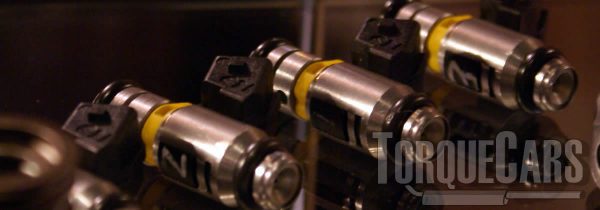
Uprated injectors will enable you to supply sufficient fuel to the engine. Increasing the fuel pressure boost valve/regulator can improve throttle response, and in many heavily tuned engines you'll need to uprate the injectors or you will run lean.
We strongly recommend a 20% leeway is added to the injector flow rates to ensure reliability as the injectors get old and this will allow a few more mods and tweaks to be added to your engine.
Uprate the fuel pump to cope with the extra fuel requirements of your tuned Passat's uprated injectors.
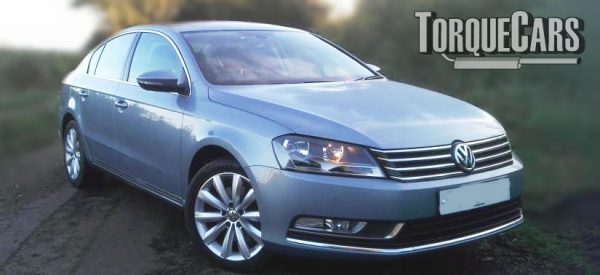
VW Passat Intake and Exhaust Tuning.
Now we move on to the intake and exhaust and ensure proper flow through the engine.
Maximum power gains come from a full induction kit BUT ONLY WHERE THERE IS A RESTRICTION, on most cars you'll see no power gains with just induction kits fitted.
On small engines, you will actually lose low down power so we suggest you use a panel air filter instead.
If you have heavily modified your engine and its need for air INCREASES DRAMATICALLY then an induction kit is the answer and will help remove this restriction.
Porting and Flowing the head
Increasing the Passat engine heads valve size, carrying out port work and head flowing will also lift torque, & importantly will afford you an opportunity to raise the torque increase on other tuning parts.
The newer the Passat engine, the less need there is for porting and flowing, this is something VAG have improved to meet the emissions regulations.
Unless there is a step that obstructs airflow into the engine, opening up the air intake port to match the intake manifold would not benefit much. As a result, most DIY port matching work is best done on the exhaust ports.
It should be noted that extending the port size is not always advantageous and is only required in highly tuned engines when the port size has become a bottleneck.
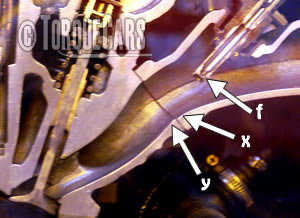 Flow rates are often improved by using slightly narrower channels with fewer bends or angles.
Flow rates are often improved by using slightly narrower channels with fewer bends or angles.
This will reduce power; the goal should be to have both port apertures to be nearly the same size in order to avoid turbulence on the downflow side, this is why many modern intakes are now made from molded plastic, it's lighter and can be made to a very precise shape.
In this image, the goal is shown of achieving a smooth connection between the intake manifold (x) and the engine port (y) in a highly tuned rally car engine.
The fuel injector (f) sprays fuel into the intake manifold and benefits from a straight path to the valves, (this obviously doesn't apply to a direct injection engine).
The intake angle has also been made more shallow so the flow is almost straight down into the engine, this is not always possible on all engines, but the focus is on smoothing the flow of air and reducing bends.
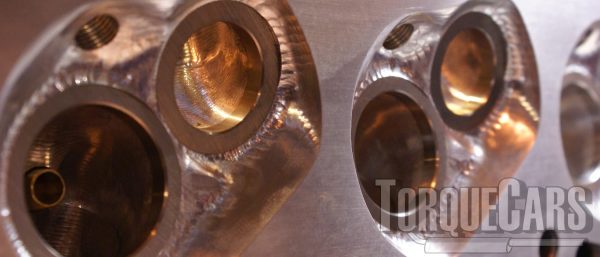
Exhaust mods for the Passat
Do not go with the biggest exhaust you can find - the best for power gains are usually between 1.5 to 2.5 inches.
On most factory exhausts you'll find your flow rate is still fine even on modest power gains, but when you start pushing up the power levels you will need to get a better flowing exhaust.
Sports exhausts generally help improve air flow through the engine but avoid an exhaust that is too big or you could will reduce the flow rate. Stick to 1.5 to 2.5 inches as a rule of thumb.
Common exhaust restrictions can be traced to the catalysts installed, so adding a faster flowing high performance alternative will help avoid this restriction.
VW Passat Wheel modifications.
Alloy wheels will help the brakes cool down and are usually lighter than the steel ones. It is worth noting that although they can look cool on the Passat Big alloy wheels will actually decrease your performance.
The larger you go the lower your top speed will be due to the change in your effective final drive ratio. Aim to keep the overall rolling diameter of the wheel the same as supplied from the factory.
In all cases, we do not recommend going above 18 inches. Some of our members have fitted 19's and 20's particularly to fit a Porsche brake conversion but they all reported tram lining and other issues from the larger rim size.
Please join us in our forum to discuss the Passat options in more detail with our Passat owners. It would also be worth reading our Passat tuning articles to get a full grasp of the pros and cons of each type of modification.
Please Check out my YouTube channel, we're regularly adding new content...
PLEASE HELP: I NEED YOUR DONATIONS TO COVER THE COSTS OF RUNNING THIS SITE AND KEEP IT RUNNING. I do not charge you to access this website and it saves most TorqueCars readers $100's each year - but we are NON PROFIT and not even covering our costs. To keep us running PLEASE Donate here
If you liked this page please share it with your friends, drop a link to it in your favourite forum or use the bookmarking options to save it to your social media profile.
Feedback - What do You Think?
Please use our forums if you wish to ask a tuning question, and please note we do not sell parts or services, we are just an online magazine.
Help us improve, leave a suggestion or tip
Please watch this video and subscribe to my YouTube channel.
6 Responses to “Tuning the Passat for more bhp power”

 Click to accept YouTube Cookies & Play.
Click to accept YouTube Cookies & Play.
I have a Passat 2.0 B6 140hp, any ideas how i can up the Hp a bit, thanks in advance.
I have the same engine. And I was actually surprised at the difference simply adding a k&N panel filter had. The HP increase will be small but the feel of the car was much improved, smoother and much more raring to go.
Thanks for your comments on tuning the Passat. I was considering some minor mods & remap, but your remarks have persuaded me not to waste my money for minimal gain, and to use good quality replacement parts instead.
I had a re map on my 2.0tdi (140) its now pushing just on 180 but I feel a massive difference overtaking never felt so easy. my mpg has gone from 46.2 to 55.4 in the 4 month i’ve had it too.
Hey Mr Wayne iam South African citizen I’m owning a vw passat 2011 B7 tiptronic 1.8 Tsi.Im facing a lot of challenges to service the Car it always misfire when I take it to mechanic for Diagnosis it w
Shows spark plug #4 causing the misfire.Help me please
This is probably a faulty lead or coilpack issue. The coilpack issue is not as common as it used to be but you can still get a bad batch. I’d recommend replacing all coilpacks as in my experience they go about the same time if they are from the same batch.